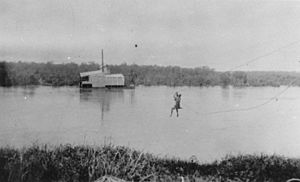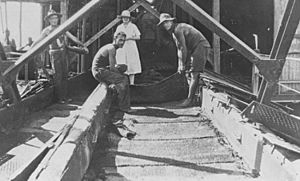Palmer River Gold Company Dredge facts for kids
Quick facts for kids Palmer River Gold Company Dredge |
|
|---|---|

Palmer River Gold Company Dredge
|
|
| Location | King Junction , Palmer, Shire of Cook, Queensland, Australia |
| Design period | 1919 - 1930s (interwar period) |
| Built | 1930 - c. 1935 |
| Official name: Palmer River Gold Company Dredge | |
| Type | state heritage (built) |
| Designated | 17 June 2003 |
| Reference no. | 601871 |
| Significant period | c. 1930 (fabric) 1930-c. 1935 (historical) |
| Significant components | pontoon, machinery/plant/equipment - mining/mineral processing |
| Lua error in Module:Location_map at line 420: attempt to index field 'wikibase' (a nil value). | |
The Palmer River Gold Company Dredge is a special old machine found on the Palmer River in Queensland, Australia. It's like a giant floating factory that was used to dig for gold in the river. This dredge was built between 1930 and about 1935. Today, it's protected as a heritage site because it tells us a lot about how people used to mine for gold.
Contents
What is a Gold Dredge?
A gold dredge is a large machine that floats on water, like a big boat. It has a long arm with many buckets that scoop up sand and gravel from the riverbed. This material is then washed inside the dredge to find tiny pieces of gold. It's a bit like a huge, floating vacuum cleaner for gold!
History of the Dredge
The Palmer River Gold Company, based in Cairns, started looking for gold along the Palmer River in 1926. They thought there was a lot of gold-rich material (rocks and sand containing gold) in the river. However, after four years, they found much less gold than they expected. They still managed to collect about 3,584 ounces of gold during this time.
The company ordered this huge all-steel bucket dredge from a company in Victoria, Australia. It was a massive machine, weighing about 350 tonnes! First, it was shipped to Cooktown, then put on a train to Laura. From Laura, the biggest challenge was getting it over the Great Dividing Range. Special six-wheeled trucks carried the dredge parts for 133 kilometers (about 83 miles) to the river. The company even built most of the road themselves!
Building the dredge was a big job. It was put together under the watchful eyes of Mr. William Condron, an engineer, and Mr. Walter Baker, the company's General Manager. Once finished, the dredge was very powerful. It had 31 buckets, each able to hold 5 cubic feet of material, and could process a huge amount of riverbed each month.
Dredging started in late 1930, even continuing into the wet season. But the river can be very powerful. In 1932, a big flood damaged the dredge, leaving it partly underwater. We don't know exactly when the dredge stopped working for good, but it was eventually left behind.
What the Dredge Looks Like Now
Today, the Palmer River Gold Company Dredge is partly buried under a large sandbar in the middle of the river. You can still see its floating base, called a pontoon, and some of its main parts. The pontoon is about 19 meters (62 feet) long and 10 meters (33 feet) wide. The entire dredge, from the front where the buckets scooped to the back where waste was piled, was about 37 meters (121 feet) long.
Most of the metal parts are still in good shape, except for some rust on the back of the pontoon. The outer metal sheets that covered the dredge are gone, but its strong metal frame and deck are still there.
Some of the dredge's important machinery is still visible. A large steam engine that used to power the dredge is now lying next to it. You can also see the gears that moved the bucket chain, though only two buckets are left on the chain. Other parts like the washing trommel (a big rotating drum that helped separate gold) and a large gravel pump are also still in place. Some parts, like the engine's base and other buckets, were removed and are now in the riverbed or on the nearby bank. The company's old campsite is about 500 meters (1,640 feet) away on the eastern bank.
The parts of the dredge that are still there include:
- A steam gravel pump made by W H Allen Son & Co Ld Bedford England.
- A two-cylinder steam engine (not in its original spot).
- Strong steel beams from the main structure made by Dorman Long & Co.
Why This Dredge is Important
The Palmer River Gold Company Dredge is listed on the Queensland Heritage Register because it's a very important piece of history.
- A Glimpse into the Past: This dredge is a rare example of the technology used for gold mining in rivers during the 1920s and 1930s in Australia. It shows us how people tried to find gold using big machines.
- One of a Kind: It's believed to be the oldest surviving steam-powered dredge in Queensland, and possibly even in all of Australia! It's a very rare example of how these early dredges were built.
- Built to Last: The dredge has survived more than 60 years of yearly floods in the river. This shows how incredibly well it was built.
- Overcoming Challenges: The story of how this huge dredge was transported all the way to the Palmer River, over mountains and long distances, shows how clever and determined people were to get it working.


